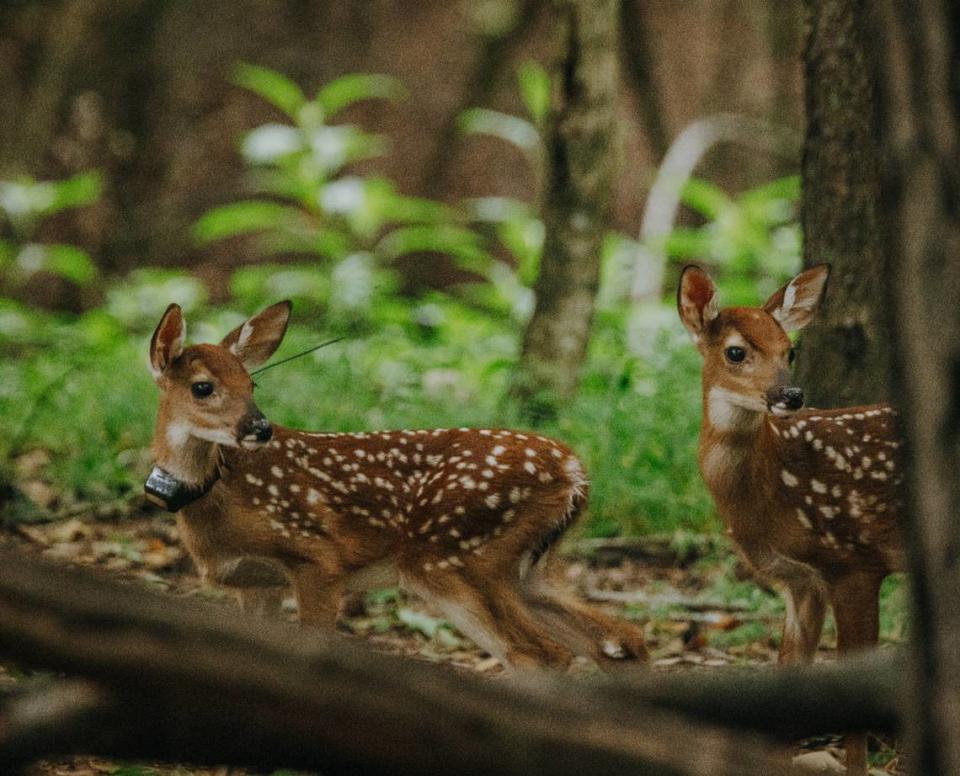White-tailed deer love the suburbs. This study is tracking them in Triangle backyards.
From January to June, N.C. State University Ph.D. student Mikiah Carver-McGinn spent hours staking out fields, treelines and backyards around the Triangle, studying the habits of frequent visitors.
Carver-McGinn’s team is tracking white-tailed deer. They’re working with the N.C. Wildlife Resource Commission on the Triangle Urban Deer Study, a dive into how deer population behavior differs across urban, suburban and rural areas in Durham and Orange counties.
In North Carolina, deer are like pets to some and pests to others — while for hunters, they’re a prey animal anchoring an entire economy. Now, the commission hopes to learn what factors influence white-tailed deer mortality and reproduction rates.
“The big takeaway for the project will be, what’s the status of these populations?” said Moriah Boggess, the commission’s deer biologist. “What are they doing? How does the public feel about it? And if there’s a change necessary in management because of that, what tools can we use to address these deer populations?”
Big cities, little deer
The study will run for three years. So far, prime locales for spotting deer have included the Museum of Life and Science and the Durham Technical Community College campus.
“We’re not necessarily going to see a buck walk down the Durham Bulls [field],” she said. “The biggest thing is, how close to urban areas can we find deer? That’s going to be how we classify them.”
The study is largely funded by the 1937 Pittman-Robertson Wildlife Restoration Act, which uses excise taxes on firearms and ammunition to match state wildlife conservation funding.
It’s part of a larger effort to understand how deer interact with changing landscapes across North Carolina, and how they’re perceived by the humans also living there.
“We’re inherently stepping into an existing relationship between the deer and the resident,” said Christopher Moorman, associate head of Forestry and Environmental Resources at NCSU.
It’s a common misconception that urbanization is taking deer out, Moorman said. But they thrive in suburban areas.
With the steady arrival of technology companies to the Triangle area, new developments are spreading fast, where deer management strategies are the least clear, said Boggess.
“We really wanted that gradient because it allows us to compare what’s going on in the city versus what’s going on in the rural landscape, which are those areas we are very used to managing,” Boggess said.
Cute or costly
As a game animal, white-tailed deer have a huge economic impact statewide, Boggess said. For rural areas in particular, hunting tourism boosts local economies, while many private landowners rely on leasing fees during open season.
The sale of hunting gear and licenses is also a major funding source for statewide ecological impact studies, Bogess said.
On the other hand, Moorman said, deer cause much damage to landscaping and crops, as well as motor vehicle accidents. Deer-related crashes in 2020 totaled 16,640 (two with fatalities and 582 with injuries), according to the N.C. Highway Safety Research Center. Wake County alone had 740 reported deer-related crashes.
He said most residents tend to have strong opinions on their local deer, and he’s noticed a fairly even split. As such, the study will help identify not only where deer go the most, but where they’re the most welcome.
“As urbanization continues,” Boggess said, “there’s more and more human-deer contact, which increases the ability for there to be conflict.”

To catch a deer
Tagging deer isn’t easy, Carver-McGinn said.
When the team finds a populated site, two or three researchers study the routines of visiting deer before setting out bait and preparing either a drop net or a sedative dart.
Once a deer has been sedated, researchers fit it with a collar that sends photos and location information to a satellite every two hours. The team has collared 76 deer to date.
Doe will wear the collars for the duration of the study or until they die. Bucks’ collars will expand when their necks naturally swell during mating season, then fall off, Carver-McGinn said.
To avoid mating and birthing seasons, collection efforts run from early January to early June. Tagged deer aren’t exempt from human activities like game hunting and deer management — the team will assess how these interventions affect population death rates.
Deer are also given bright yellow ear tags, which Carver-McGinn says have helped raise awareness and interest for the study. Because deer often roam around backyards or other private land, Carver-McGinn said, researchers have to persuade residents to let researchers onto their property at 15 to 20 fieldwork sites at a time.
She’s knocked on a lot of doors around Durham County this year.
“Our technicians are regularly interacting with the public,” said Nathan Hostetter, an assistant professor of Applied Ecology at NCSU. “It’s a very front-facing project that way.”
Boggess said that deer’s ecological niche in the Triangle is unique, and so the results of the study will be very specific. The NCSU team, though, hopes to answer larger questions about the effects of urban sprawl on native wildlife.
The study also touches on mortality factors that affect small animals beyond deer, like vehicle collision and hunting rates.
“This has changed me,” Carver-McGinn said. “This is really a deer study. But there’s a lot of things that apply to other species. … There’s a bit of growth to be had there.”
The Durham Report
Calling Bull City readers! We've launched The Durham Report, a free weekly digest of some of the top stories for and about Durham published in The News & Observer and The Herald-Sun. Get your newsletter delivered straight to your inbox every Thursday at 11 a.m. featuring links to stories by our local journalists. Sign up for our newsletter here. For even more Durham-focused news and conversation, join our Facebook group "The Story of my Street."

